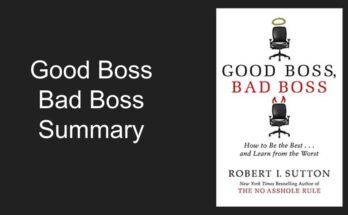In this detailed the dichotomy of leadership summary by chapter, we will see each of the chapters in depth.
If you have read Extreme Ownership by Jocko Willink, the dichotomy of leadership will be a great companion to that book.
The dichotomy of leadership summary by chapter will discuss each chapter in detail, however, this is a must read book for all emerging leaders.
The dichotomy of leadership summary by chapter- Finding Balance
The goal of all leaders should be finding out the balance between ownership and accountability.
Leaders have to work themselves out, and empower the teams to take responsibility and accountability of the results.
Leaders take full ownership of the outcomes whether positive or negative, this creates a culture of accepting mistakes, learning from them and taking responsibility for the mistakes.
You can get free Audiobook of The Dichotomy of Leadership here.
Team feels confident to communicate freely in the organization, hence it keeps things simple and achieves highest priority tasks easily.
The dichotomy of leadership summary by chapter will cover all 3 parts and 12 chapters of the book. However, for detailed understanding I highly recommend this book.
Part 1 Balancing People
The dichotomy of leadership Chapter 1 Summary – The ultimate dichotomy
Leaders are expected to manage the ultimate dichotomy that is caring for the people as well as getting things done.
They care deeply for their team members but they also accept the necessary risks of accomplishing the objectives.
So the leader has to find balance between building strong relations with the team while keeping the ultimate objective in mind.
As a leader you can’t compromise any of them, you need to achieve goals as well as care for the people.
If you think about taking care of team members too much you may compromise on objectives. On the other hand you also can’t just be focused on objectives that you neglect people.
A good leader finds the way to achieve objectives without pushing the team to the edge.
The dichotomy of leadership Chapter 2 Summary – Own it all, but empower others
If you have read Extreme Ownership, you must know leaders take ownership of all outcomes whether positive or negative, they do not put blame on their team members.
However, if the leader keeps the same approach with decision making it becomes micromanagement.
A good leader has to find a fine balance between micromanagement and hands off leadership.
“With Extreme Ownership,” concludes Willink, “you are responsible for everything in your world. But you can’t make every decision. You have to empower your team to lead, to take ownership. So, you have to give them ownership.”
Micromanagement can result in lack of initiative, no creativity, less problem solving, team operates in silos and less or no proactiveness of the team.
Hands off leadership can result in lack of vision, bad coordination, and too many people trying to lead.
The dichotomy of leadership Chapter 3 Summary -Resolute, Not Overbearing
Leaders have to find balance between being too easy going or too strict. The authors explain this with “Leadership Capital” and “the Why”.
Leadership Capital – is the finite power leaders have with them, if they waste this power on benign tasks, they may not have it when they need it.
Leadership capital is like energy. You want to use it when it really matters.
The Why – it means the leader should give good reasons to the team to listen and follow instruction.
Leadership capital can be used to explain the Why to the team members, it can be a good influence and right use of the leadership capital.
So, Leaders have to be resolute and not overbearing on the team.
The dichotomy of leadership Chapter 4 Summary -When to mentor, when to fire
There are no bad teams, only bad leaders. Another important lesson from extreme ownership.
Underperformers are needed to be led properly, they may not be needed firing immediately.
But as a leader if you have given all the mentoring, a chance to improve performance and still the individual does not perform. Leaders may have to just let them go.
Leaders can provide their team with coaching, counseling and mentoring as and when required.
At the same time leaders also have to hold the line and get rid of habitual under performer to safeguard the team.
Part 2 Balancing Mission
The dichotomy of leadership Chapter 5 Summary -Train Hard, but Train Smart
The authors believe hard training is necessary to push a team out of their comfort zone and is critical for performance of any team.
Training should be such that allows the team to push their limits daily and prepare them for future challenges.
There are three critical aspects of any training
- Realism
Training must be realistic where it pushes the team and leader to uncomfortable situations where they are required to take hard decisions. These situations should be such where they do not know what to do and really need to think out of the box.
- Fundamental
Training must be focused on fundamental concepts, these are the concepts which we ignore or want to skip through. In reality the brain and memory do not work that way. Always include fundamentals if you really don’t want to forget them.
- Repetition
Training must be repetitive, the brain learns more with repetition and it is proven research.
The dichotomy of leadership Chapter 6 Summary -Aggressive, Not Reckless
Jocko Willink shares that “An Aggressive mind should be the default setting of any leader.”
Here Aggressive mind does not mean an angry mind, it is simply a proactive mind, where no actions are missed.
Leaders are required to react to the worst possible scenario in the best possible way, and may not lose temper easily.

Aggression towards the problems can win the games, instead of aggression towards people.
Leaders must get aggressive to solve problems and not the people.
When leaders become aggressive without critical thinking they become reckless.
Apart from that, the leader may suffer from the disease of victory if he keeps winning all the games.
So, leaders must be always aggressive to solve problems, achieve goals and to build the teams.
The dichotomy of leadership Chapter 7 Summary -Disciplined, Not Rigid
Believe me or not discipline gives you more freedom, you can set process and procedure to follow and remove guesswork out of the system.

Standard operating systems, repeatable processes, and consistent tools can build habits in the team to drive consistent results for organization.
Process should not be rigid that it does not allow deviation even when it is necessary for desired outcome.
Leaders should drive discipline with freedom to explore better alternatives and progressive changes.
The dichotomy of leadership Chapter 8 Summary -Hold People Accountable, but Don’t Hold Their Hands
Accountability is an important tool but should not be the only tool.
Accountability with empowerment to make necessary adjustments can allow a team to grow.
The leader should make the team understand the reasons (why) and not hold them accountable for results.
The leader must empower the team to take ownership of the tasks, and make necessary changes if needed to achieve a common goal.
Team should be able to see the overall impact of these tasks on organization, and what can be the consequences of failure.
Part 3 Balancing yourself
The dichotomy of leadership Chapter 9 Summary -A leader and A follower.
Leader should empower team members, such that they don’t depend on him for trivial decision making.
Leaders should not make subordinates feel like they are beneath them instead allow them to be more creative, initiative taking and make their decision.
Sometimes a leader’s role is to follow subordinate, Leader should be ready to listen and follow them.

They should be open to accept, if a junior has better knowledge at something, or has a great idea than himself.
A great leader knows it does not matter who gets the credit, at the end mission should be accomplished and goals must be achieved.
The dichotomy of leadership Chapter 10 Summary -Plan, but don’t overplan
One of the obvious traits of the leader is being able to plan ahead, the team that can see further in future are the teams who wins.
However, leaders should refrain from overplanning. In reality there are a number of scenarios that can not be simply planned, or sometimes planning too much can take away spontaneous and creativity.
Leader should prepare the team for the worst case scenario or few emergencies if needed.
The dichotomy of leadership Chapter 11 Summary -Humble, not Passive
“Leaders must be humble enough to listen to new ideas, willing to learn strategic insights, and open to implementing new and better tactics and strategies,” writes Babin.
“But a leader must also be ready to stand firm when there are clearly unintended consequences that negatively impact the mission and risk harm to the team. “
Again it is about a balanced leader who must be humble but not to the extent that it becomes passivity.
The dichotomy of leadership Chapter 12 Summary -Focused, but detached
Too much attention to details can become a liability and may delay the decision making in general.
Leaders must be able to stay focused but detached with too much of the details that come daily.
In this blog we tried to cover the dichotomy of leadership summary by chapter in detail. I highly recommend this book to all new managers.
Read Detailed blog about 360 Degree Feedback.


